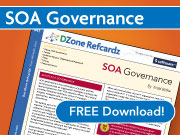 Gartner AADI: Schulte Keynote
Gartner AADI: Schulte Keynote
Roy Schulte is delivering the opening keynote. Right now, he’s presenting a good slide on integrating applications from outside of your domain and emphasizing the role of metadata and policies in formalizing the agreement between service consumers and service providers, all because of the need to build applications that cross the boundaries of different domains, whether inside the enterprise or outside the enterprise. I agree!
Roy’s now presenting what he feels will be the major improvements in business computing over the next 5 years. They are:
- SOA, EDA, REST, BPM, and SaaS will improve the long-term business agility while reducing the life cycle cost of application systems.
- BAM is IT’s biggest near-term opportunity to shine.
- End users will have more direct control over the applications they use, and IT solutions will be more customized.
- IT systems will become better able to handle data in the form of documents.
- End users will participate more actively in information capture, information sharing and collaboration.

Schulte’s point “SOA, EDA, REST, BPM, and SaaS will improve the long-term business agility while reducing the life cycle cost of application systems.”
I respectfully disagree. Has he forgotten history? Time after time this claim has been made. Yet noone talks about the benefits gained from the approaches and technologies adopted 5-10 years ago.
Virtually all analysts say the real ROI is 5-10 years out but we never seem to get there.
It reminds me of an old software development joke–“we’re 80% done, just need two more weeks.” Asked two weeks later, the answer is the same, “80% done, two weeks out.”
This paper from 2002, http://www.gartner.com/resources/111900/111987/111987.pdf, speaks of the same benefits with a bit of difference on the alphabet soup that is used. In 5-10 years will we find ourselves in another Schulte presentation with a very similar bullet point?
It’s not that I think the approaches and technologies are useless. The successful items simply become the way we do things (e.g. OO programming, various design patterns, etc.). It’s hard to argue that we’re not more productive now than when we were slinging PL-I or COBOL. But rarely do we measure and objectively show improvements over the long term.
So I’m calling “shenanigans” on the claims of improving long-term business agility and reducing the life cycle cost. We won’t stick with the approaches and technologies long enough to measure or we won’t measure, making the claims all but anecdotal.
Thanks for the comments Rob. I haven’t had a chance to really digest Roy’s items as I’ve been running between sessions. The one you call out is certainly one of those high level goals that are incredibly hard to either prove or refute, unfortunately. I’d be more comfortable with someone presenting some decent ways of measuring business agility first, and then we can actually have meaningful debates on whether any particular technique or technology has a causal or contributory relationship toward it.
“…more comfortable with someone presenting some decent ways of measuring business agility first…”
I agree 100%. This is similar to my desire that SOA proponents focus a little less on governance and registries and service interactions and the like and much more on how to create/define a good, robust service and its interface(s).
“I agree 100%. This is similar to my desire that SOA proponents focus a little less on governance and registries and service interactions and the like and much more on how to create/define a good, robust service and its interface(s).”
Amen to that Rob. There seems to be almost no focus on good service design. You can have the best governance in the world but crappy services are still crappy services.